10 years down the road since the financial crisis. Where are we now?
The Great Financial Crisis is very much associated with the spectacular bankruptcy of Lehman Brothers on 15 September 2008, i.e. exactly 10 years ago these days, although the crisis started earlier, see e.g. this (very) detailed timeline.
As we know, the crisis spread from USA to Europe and certainly also to Latvia where a massive credit boom and real estate boom had fueled exceptionally high growth rates. Between 2003 and mid-2007 growth rates were never below 6% on an annual basis and for the whole period of 2005 Q3 through 2007 Q3, growth rates were consistently in double digits, see Figure 1.
Figure 1: Economic growth in Latvia, 1996 Q1 – 2018 Q2, seasonally adjusted data
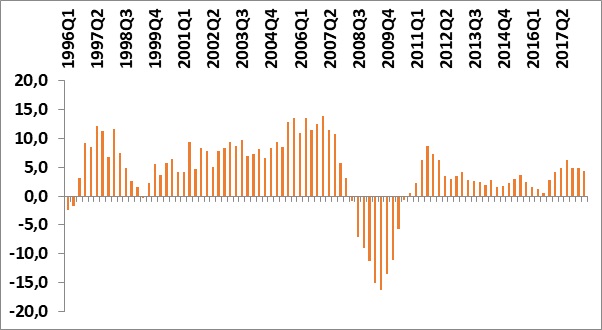
Source: Eurostat
Latvia enjoyed uninterrupted growth for 35 quarters (1999 Q3 through 2008 Q1) although a slowdown started at the end of 2007, see Figure 2 that zooms in on the slowdown and the subsequent recession.
Figure 2: Economic growth in Latvia, 2007 Q1 – 2010 Q4, seasonally adjusted data
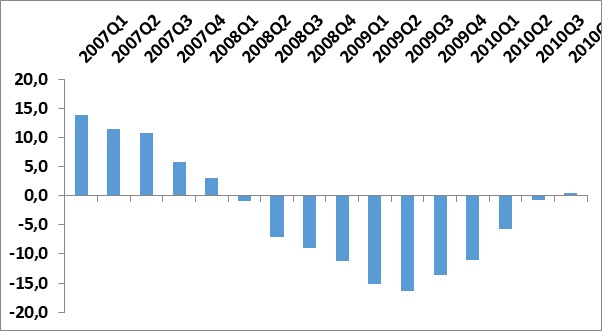
Source: Eurostat
When credits stopped flowing, construction came to a halt, real estate business went south, banking was hurt and eventually the whole economy. Main events may be the nationalization of Parex in November 2008 and the IMF-EU assistance programme of December 2008.
Employment went off a cliff as unemployment skyrocketed – between April 2008 and April 2010, a mere two years, 243,400 jobs were lost, a staggering 22.5% of employment at its peak, see Figure 3.
Figure 3: Employment in Latvia. Number of employed persons (1000s), 2002-I – 2018-VII
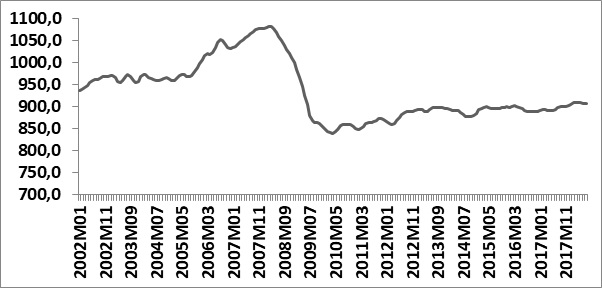
Source: Central Statistical Bureau
Due to poor demographics and not least migration, employment never recovered and never will; employment will forever remain far below its level 10 years ago and the Latvian economy will forever be transformed.
The recession was ultra-deep but relatively short. Growth resumed at the end of 2010 and since then the economy has seen uninterrupted growth up until today, a period of so far 31 quarters, i.e. a period not much shorter than the ‘fat years’.
Time to expect another crisis? I would argue, not at all – there is no credit boom at all at the moment and almost all indicators are well-balanced at the moment. Just one exception: The labour market. Employment may not at all have returned to its pre-crisis level but unemployment has – almost eight years of growth together with poor demographics and outward migration has reduced the unemployment rate considerably, see Figure 4.
Figure 4: Unemployment rate in Latvia among 15 – 74 year olds, 2002-I – 2018-V
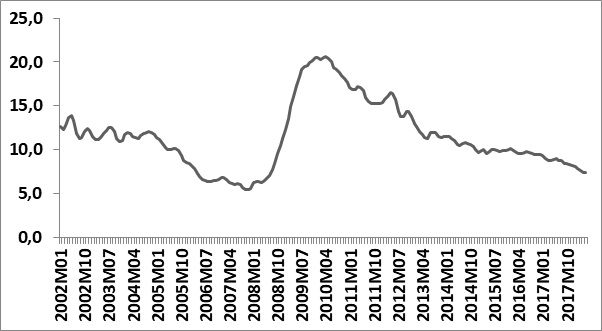
Source: Central Statistical Bureau
At 7.4% the unemployment rate is at its lowest since July 2008 and for only 26 months during the big boom was it ever lower.
In short, the labour market has tightened considerably and labour shortages now and in the immediate future should be the country’s main economic problem for now. This may reduce growth rates but there is no reason for why it should cause a recession.
In short, except for the labour market, Latvia in 2018 is much different from Latvia in 2008. We should be happy about that.
Morten Hansen is Head of Economics Department at Stockholm School of Economics in Riga and a member of the Fiscal Discipline Council.
Points of view expressed here are not necessarily those of the Fiscal Discipline Council.

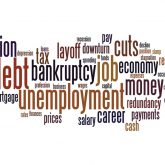




Pagaidām nav neviena komentāra